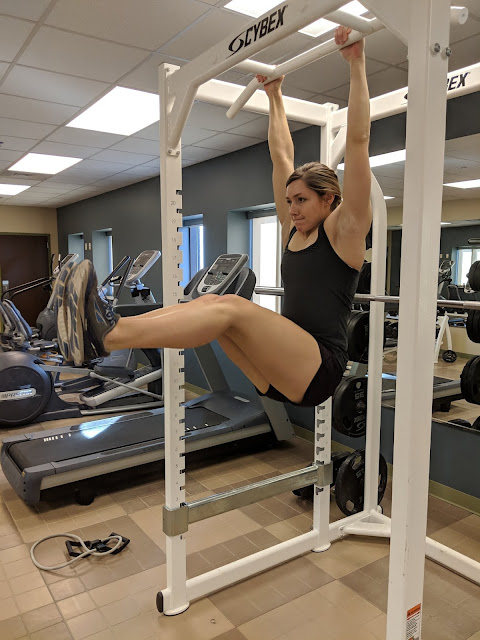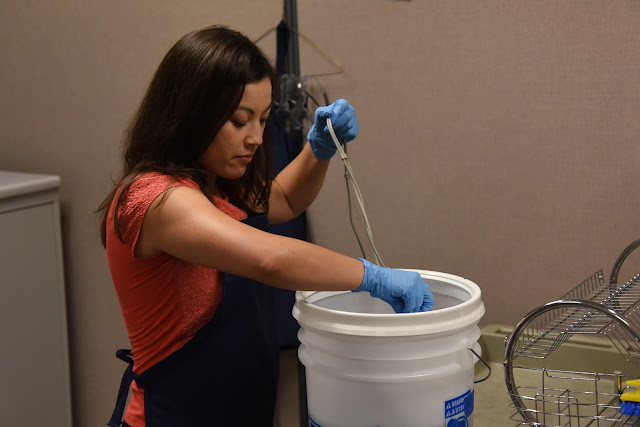Pain, perseverance and the long road to recovery
Story by Maj. Thomas Piernicky
4th Sustainment Command (Expeditionary)
Wearing shorts and a tank top, a lone figure is putting herself through a punishing workout routine during a lunch break at the Colorado Spring Army Reserve center on a Thursday afternoon. She rotates between a variety of exercises all designed to strengthen her core muscles. The exercises challenge her to push through pain and tense muscles to maintain her fitness.
This is 1st Lt. Gennifer Thompson, a military intelligence officer and Army Reserve soldier with the 90th Sustainment Brigade based in Little Rock, Arkansas. Thompson is getting in a quick workout while on temporary duty to attend suicide prevention training. Two years ago, Thompson would not have been able to do these exercises after suffering a debilitating spinal injury during an ROTC ruck march.
Despite the crippling injury, Thompson has demonstrated mental and physical resilience while working hard to recovery from a spinal disc replacement surgery. To understand how bad her situation was, you must go back to October 2014 where it all started. “I was on a Ranger Challenge team through ROTC,” said Thompson. “The fall of my junior year, we were at the Ranger Challenge competition and there was some mess up with land nav and the ruck was extremely long.”
“A lot of teams quit but we finished,” said Thompson. “I remember bracing my hips for the last half of the ruck and when I finished, I just dropped my pack and laid on the ground. Tears just started falling. Something was definitely wrong.”
Thompson laid on the ground for a while and was soon released to go home by the ROTC leadership. Although she didn’t know it at the time, Thompson had ruptured the disc in her spine between the L4-L5 vertebrae. Such injuries can be extremely painful and typical symptoms include sharp pain down the back and weakness in the legs. Before long, Thompson’s injury began to complicate everyday life.
“The injury took over my life,” said Thompson. “It was a long road to find out what was the matter and a long road to get help and a long road to recovery.”
Her injury complicated her military career by delaying training until her injury was fully addressed. Although she got her commission in 2015, she was unable to attend her Basic Officer Leadership Course for Military Intelligence until the fall of 2018.
To make matters worse, her ability to function during daily life was limited. She had to cut out roughly 75% of her gym routine as her condition deteriorated rapidly.
“I couldn’t even sit or travel in a vehicle,” said Thompson. “I remember travelling to drill, being in so much pain all weekend and travelling home and having to get out of the car and lay on the side of the highway multiple times before getting home.”
Thompson said her pain level was a seven out of ten daily but would spike with even the smallest movements.
“I would wake up screaming in the middle of the night if I twisted wrong and it would just scare everyone in my family,” said Thompson.
Thompson consulted several medical personnel whom prescribed a variety of means to combat her condition. Muscle relaxers, several months of physical therapy and numerous trips back to the doctor all failed to improve the injury.
“I did three months of physical therapy and it was not better,” said Thompson. “I waited another month and made an appointment. Two months later I went back to the same doctor.”
“Something was not better, something was really wrong,” said Thompson.
Trips outside the home sometimes ended up in disaster. On one such occasion, Thompson and her husband were at a car dealership buying a truck. As Thompson leaned over to sign a check, her disc went out.
“I was laying on the floor of the dealership, in a very public place, just screaming and feeling so helpless,” said Thompson. “There were a lot of moments like that.”
As her condition worsened, she struggled with simple tasks. She recalled a time when she could no longer bring in the groceries from the car as her pain level prevented her from picking anything up.
“They spoiled in the car while I waited for my husband to be able to bring them in because I couldn’t pick up anything off the floor,” said Thompson.
At its worst, Thompson’s condition was so bad she started losing bladder function. She didn’t want to leave her home and be away from a bathroom. Sitting for long periods made her symptoms worse and she spent most of her days lying down with her legs elevated.
“Right before my surgery, there was so much nerve damage I couldn’t walk or run or go anywhere,” said Thompson. “I was just ready to get in a wheelchair.”
Thompson started to question what the rest of her life would be like.
“I’m not going to get fixed, this is going to be how I am for the rest of my life,” said Thompson. “I can’t have kids, I don’t know what the future looks like.”
Thompson’s husband, 1st Lt. Wayne Thompson, an infantry officer with the 3rd Brigade, 10th Mountain Division, stationed at Fort Polk, Louisiana, felt helpless as his wife’s condition worsened. Wayne Thompson has a master’s degree in athletic training, previously worked as a strength conditioning consultant and cross fit coach but could find no way to fix the problem and stop his wife’s pain.
“There was no relief at any point,” said Wayne Thompson. “It wasn’t better when she wasn’t being active. It wasn’t better when she was sleeping. There was no alleviation of her suffering at any point.”
Wayne Thompson developed workout routines designed to help his wife. After these efforts failed, Wayne Thompson felt the stress and helplessness building.
“How do you deal with someone you love being in agony every single day,” asked Wayne Thompson. “For me that answer is it was extremely stressful, and it tried our connection very often and very strenuously.”
Despite the strain, the Thompsons maintained faith in each other through their ordeal. After several more trips to the doctor, Thompson got a second MRI and was referred to a spinal specialist. One doctor said she was too young for a spinal fusion and the decision was eventually made to do a full disc replacement. All that was needed now was for the official paperwork to get processed authorizing the procedure.
Another episode of crippling pain sent Thompson to the emergency room while she waited for the authorization.
“I had went to the ER for the sixth time,” said Thompson. “It was over a weekend, but that Monday I called the unit and told them that I went to the ER and needed surgery immediately.”
Thompson’s command helped expedite the paperwork. In May of 2017, Thompson was finally authorized to get the spinal replacement surgery and she and her mother drove from Georgia to San Antonio. Thompson’s husband was still in his Infantry Officer Basic Course and was unable to be with his wife.
The surgeons planned four hours for the procedure, but complications arose.
“The surgery was supposed to be four hours, it took a little over seven,” said Thompson. “I had done so much rehab and strengthening around my core and lower back to protect my spine that going thru muscle is very difficult and delicate so were taking their time having to cut through so much muscle.”
Thompson said during the operation, surgeons tore an artery and had to clamp it to prevent blood loss. With the surgery completed, Thompson’s recovery was just beginning. Thompson stayed in the hospital for five days but was in San Antonio for two weeks to make sure everything was ok. During this time, she had a reaction to her pain medications.
“I had to switch medicines and in the process of that switch, I became unmedicated and my body started to seize up from muscle spasms from being in shock,” said Thompson.
Thompson’s command offered her a chance to be medically discharged but she declined. She was determined to make a recovery, even if the process would be slow. Common, every day activities were a personal challenge.
“I wasn’t allowed to do anything for 30 days,” said Thompson. “The first 30 days I had trouble putting on my shoes and my own clothes. I didn’t have the mobility to put my sock on and it was scary.”
After three months Thompson was allowed to start physical therapy consisting of isometric training. Thompson said her first session focused on planks and wall sits, which she found very hard to do. At four months post operation, Thompson started running. Her first mile took 14 minutes to complete and caused her resolve to falter.
“I definitely had some discouraging, eye opening things, like that first run,” said Thompson. “That was almost 15 minutes for a mile, and I was just like, I’m going to give up. I can’t come back from this.”
Thompson credits her husband for helping her stay motivated by giving her constant encouragement during her recovery. That encouragement paid off as Thompson ran a 10k at the end of her fifth month, in which she placed first in her age group.
“That was very rewarding,” said Thompson.
A year and a half later, Thompson has made a near full recovery.
“Now I feel like I am about 90%,” said Thompson. “The doctors say I’m good to go.”
Thompson’s typical workouts now include deadlifting over 200 pounds, squatting close to 200 pounds and working on regaining her speed.
“I can ruck, and I can do pretty much everything I want to do but my mindset is different now,” said Thompson. “I’m a lot more careful of what I do. I make sure what I do is very balanced.”
As to Thompson’s long-term prognosis, there is still uncertainty. Thompson said medical providers have only been doing this surgery for about 30 years and there are few studies to evaluate their effectiveness. For now, Thompson said that strength training around her spine can help maintain her current mobility.
“Currently I do four strength training sessions and six conditioning sessions a week with one rest day,” said Thompson.
Thompson’s resolve waivered at times, but in the end, she never gave up and encourages others to not give up on their health or goals.
“I would like people to know that it is really important for you to take care of yourself and to advocate for your health,” said Thompson. “Rely on the family support systems that you have because when you come down to it, those are the most important things in life. Your family and life.”
For those seeking more information about the US Army Reserve and how to become a citizen-soldier, please go to https://www.goarmy.com/reserve.html
The 90th Sustainment Brigade is part of the 4th Sustainment Command (Expeditionary). The 4th ESC is made up of Soldiers, civilians and their families in units headquartered throughout Texas, New Mexico, Arkansas, Oklahoma and Louisiana. As part of America’s Army Reserve, these units are trained, combat-ready and equipped to provide military and logistical support in any corner of the globe.




Comments
Post a Comment